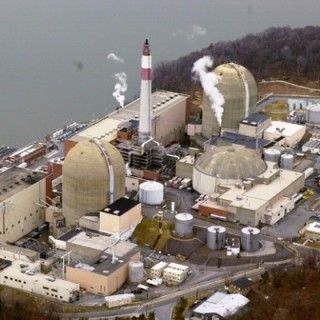
A new report reckons the water cost of electricity generation
Power plants are guzzling water across the United States and increasing the risk of blackouts in the Southeast, where the precious resource is drying up.
"Burning Our Rivers," a new report by the River Network, found that it takes about 40,000 gallons of water to meet the average American household's energy needs, which is five times more than the amount of water used directly in that home.
Of the various modes of power production, hydropower has the biggest water footprint. Each day, enough water evaporates from behind hydroelectric dam reservoirs to meet the demands of more than 50 million people.
Coal-, nuclear- and natural gas- powered plants are also thirsty, in need of water to cool their generators. These energy facilities are the fastest-growing users of freshwater resources and already account for more than half of all fresh surface water withdrawals from rivers. That is more than any other economic sector, including agriculture, write the authors.
More than a quarter of the water fossil-fuel plants take in is turned into steam. The remaining liquid is contaminated with pollutants and excess heat and returned to waterways, where it can kill wildlife and create toxic algae blooms.
"What we are seeing now is the way we produce electricity can threaten our water supplies, and it's already compromising our water quality across the nation," said Wendy Wilson, director of River Network's energy and climate program and author of the new report.
The results found in "Burning Our Rivers" echo a report released last fall by the Union of Concerned Scientists (UCS), which also found that conventional power plants are stressing U.S. lakes and rivers by removing too much water or discharging it at extremely warm temperatures, to the detriment of surrounding ecosystems (ClimateWire, Nov. 15, 2011).In the Southeast, which has been battling a drought for more than a year, the impact of power plants is especially worrisome and could lead to brownouts and blackouts throughout the summer and beyond.
"The conflicts between energy and water needs are ones we've seen before ... and will only worsen as the frequency of drought increases and water temperatures rise driven in part by climate change," said Ulla Reeves, regional program director at the Southern Alliance for Clean Energy.
'Disasters in slow motion'
Alabama and Georgia have been particularly hard hit this year, with the drought reaching exceptional levels that are predicted to continue and even worsen through September. Todd Rasmussen, a hydrology professor at the University of Georgia, says that taking strong energy conservation measures may be the only way to avoid losing electricity.
"Worst-case scenario for energy and water shortages later this summer can be avoided if we take time now to prepare," he said. "Unlike a hurricane, tornado or earthquake that strikes quickly, these droughts are disasters in slow motion. It's something that we could prepare for."
The River Network report says the long-term solution to reducing water consumption for power production is to switch from conventional energy sources to wind and photovoltaic solar power, which have almost no water footprint.
Alabama is currently looking at all options for managing its fragile water-energy nexus and to meet Republican Gov. Robert Bentley's call for a comprehensive water plan by 2013. According to Mitch Reid, program director at the Alabama Rivers Alliance, the state has no official water management plan to ensure that users get the water they need while enough is left over to protect the river network itself.
"Efficiency in our water use and making sure that we're not wasting water or wasting electricity, which in turn uses more water, has got to be addressed in part of a comprehensive plan," he said.
The nation needs a plan, too, said Wilson, if it is going to weather the existing and expected water shortages.
"It's not clear that the water and energy agencies are in a process where they are talking about these scenarios and building the resilience that we need to face these kinds of challenges," she said. "Is someone managing the farm here on integrating our water and energy needs? Or are we just praying for rain?"
Reprinted from Climatewire with permission from Environment & Energy Publishing, LLC. www.eenews.net, 202-628-6500



This drought is man made by geo engineering aka chemtrails. All for the weather derivatives market. Oh, and also for MONSANTO to introduce their drought resistant geo seeds.